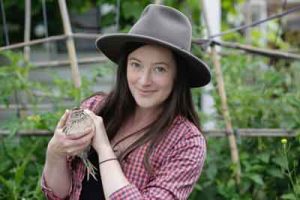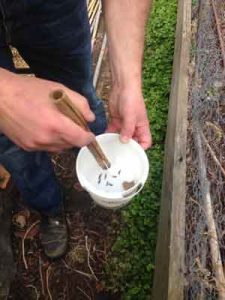 Sustainable Gardening Champion Kat Lavers, has made major achievements as an advocate for sustainable food systems. She is a member of SGA’s Green Gardening Professionals (GGPs) and we met with her to learn about her pathway gardening sustainably, her vision for future sustainable cities and urban food systems and simple ways home gardeners can make the most out of growing food where they live.
Sustainable Gardening Champion Kat Lavers, has made major achievements as an advocate for sustainable food systems. She is a member of SGA’s Green Gardening Professionals (GGPs) and we met with her to learn about her pathway gardening sustainably, her vision for future sustainable cities and urban food systems and simple ways home gardeners can make the most out of growing food where they live.
The Plummery: An Example for Us All
Kat is a strident advocate for reconnecting with our food in cities, and her garden, The Plummery, undoubtedly demonstrates the feasibility of growing an abundance of food on an ordinary suburban block.

Her original 1/14th acre suburban block on Wurundjeri Country (6km from Melbourne CBD) has undergone remarkable transformation in the 12 years Kat has owned it (compare the picture at left with the header image). Today, the block now boasts a highly productive, 100m2 urban permaculture system. The garden provides almost all the fresh produce consumed by the household (2 adults and regular guests) except for space-hungry bulk crops like onions, pumpkins, potatoes and passata tomatoes. A mind-boggling 450kg of produce was harvested on-site in 2020 (which will soon increase to over half a tonne once young fruit trees mature!). And Kat estimates that it only takes an average of 4hrs/week of maintenance work.

The Plummery is a remarkable experiment in growing an “abundance of produce in the city, food right outside your backdoor with no transport, no packaging, almost no mains water or external nutrients coming in”. Kat’s meticulous record-keeping of The Plummery’s harvests provides “important data for the community to have & to prove the value of these backyard systems”.
However, Kat acknowledges there remain barriers – particularly secure access to land – to wider adoption of sustainable food growing in cities. “It’s become so hard for people renting. You can definitely grow great food in a rental garden, but there are limits to it, you have to be creative and it’s easy to get discouraged”.
Skill-sharing and creativity are necessary antidotes to the current disconnect between people and their food in urban areas. Kat says, “we need a lot more people growing in rentals sharing what they’re doing to help people see what is possible”.
Kat’s recent blog series Gardening in Hard Times – published advice encouraging people affected by lock downs in Melbourne last year to learn how to grow food where they live.
Kat’s Pathway to Sustainable Gardening
Kat’s has been largely influenced by her experiences as a WWOOF’er and through her interactions with permaculture educators/facilitators over the years. She emphasises that permaculture design has been the most important tool guiding processes of learning through observation, decision-making, and adaptation in the garden. She has been motivated by a sense of moral duty, commitment to ethical principles of inter and intra-generational equity and sustainable gardening “just makes sense” – for small sacrifices in comfort, luxuries/convenience and time. She also enjoys its benefits: financial, improved physical & mental health, sense of community & belonging and above all – reducing her household’s environmental footprint and even making contributions to local ecosystems (eg. by providing habitat for insects and animals).
The Plummery’s veggie beds are organised around a tight rotational cropping system that uses stacking, successional and companion planting techniques to maximise crop diversity and consistency of harvest while minimising maintenance and pest control requirements. This carefully honed design is the culmination of years of experimentation and ongoing adjustment to planting, sowing and harvesting plans.
Such a dynamic approach involves ongoing changes in the garden as well as the kitchen. Including becoming creative in the kitchen to make use of surpluses, such as the feijoa and walnut loaf Kat proudly plated up for me. A craving for wider fruit variety drove a recent re-design and replanting of trees, which now features multi-plant and multi-grafting techniques to make the most of vertical space and create a dense orchard that supplies fruit almost year-round.
The trade-off between productivity and aesthetics has also been renegotiated over the years in Kat’s garden; “I started off really caring about function and not caring about aesthetics… and then gradually I began thinking – I enjoy working in spaces that I find beautiful, and I’m drawn to them… that means I do better observation, better learning, better maintenance… so that feedback loop means that a beautiful garden is also likely to be more productive”.
Kat reflects on the necessity of perpetual learning in the pathway towards more sustainable gardening and abundant food growing; “we’re not there yet and we’re certainly not a perfect example, but every year we try something new, and wonder how we can do things a bit better”.
Kat’s Advice for Designing and Maintaining a Sustainable Garden
Kat recommends “do[ing] what makes sense and try(ing) to take little steps every year to reduce your dependence on imported materials”. “We need everybody doing sustainability a bit better, rather than a few people doing it perfectly”. A few key factors are:
-
It all starts with good design…
With good design, you can maximise productivity and biodiversity while saving time, effort and resources in the long run. Kat says, “it starts with healthy soil, and trying not to force a plant to grow in a place that it’s not suited to, where it’s very prone to pests, then providing habitat for parasitic insects”.
“With good design, you’ll have places to sit at different times of day that are beautiful and enticing and will draw you out there, so you’ll want to be out there having a cup of tea and it will naturally lead to observation and maintenance and harvesting.”
Deliberate zoning that puts elements requiring the most maintenance (eg. quails, annual veg) on often-walked pathways makes it easy and convenient to quickly do jobs without going out of the way. “For example, to get to the house you need to go through the annual veg and past the quails, so it’s easy to notice a hole in a leaf and pull off a juicy caterpillar and some leaves to feed the quail, scan the birds for any issues, then check their water and collect eggs, and finally weigh the produce just outside the back door.”

Close and frequent observation of an earwig infestation led Kat to realise that bamboo be a trap for harvesting earwigs as a high protein feed for the quails, and to reduce damage to spring seedlings in the vegie beds.
-
Taking advantage of surplus nutrients where you live!
“Growing food in the city is so important because this is where nutrients and resources are concentrated.”
Kat emphasises that harvesting excess nutrients from our households – that is, greywater, food scraps, human waste, is one of the most significant steps home gardeners can take in working towards more sustainable, closed-loop gardening systems.
“The key point is that we’re in a really drought-prone part of the world and at the same time, we’ve got all this greywater that’s used in homes that can be safely used on fruit and nut trees without any special treatment, just by getting it into healthy, mulched soils.”
This means that the sustainable garden doesn’t stop at the back door – from the bucket system harvesting water in the shower that Kat’s confident “just about anyone renting who can lift a bucket can do”, to the solutions that are less well promoted and require greater work, resources, or creativity initially (especially if renting). A grey water harvesting system irrigates Kat’s fruit and nut tree beds, which alongside two water tanks, reduces the need for mains water supply as well as a compost toilet system.
“To produce food right outside your backdoor with no transport, no packaging, almost no mains water or external nutrients coming in, I think that’s amazing.”
-
Grow what you can, share, trade, and source locally to fill in the gaps
Kat recommends establishing goals for your food-producing garden – especially if you are limited in space, time, or other resources. Urban growers should focus on growing “the things that contribute a lot nutritionally, that are often overpackaged, and expensive in terms of energy to transport to you. Things like leafy greens – that is a huge contribution you can make by growing them at home.”
Following this, Kat recommends, “doing your bit to support sustainable growers where your budget allows and “sharing and foraging wherever possible”
A vision of the future
Mitigating the impacts of climate change
“Growing food at home tackles [emissions and efficiency/wastage] in many ways,” including overcoming the need for complicated treatment (e.g. greywater), storage (e.g. refrigeration) and transport of produce that is necessary when you separate people from their food.
“Home food growers also tend to accept a wide range of grades of produce, there’s no cucumber that is ‘the wrong size’, we eat everything, and we accept pest-damaged produce, we’re not impacting on biodiversity in the way that many commercial producers have to, because they have to control for aesthetic damage”
Building more sustainable and resilient urban food systems
Kat emphasised that as many people as possible supporting bioregional food systems, and sourcing from local producers, not sourcing imported, heavily packaged foods will ensure greater equity and efficiency in the distribution of quality, healthy produce.
“Those food systems that supply the major supermarkets come at a very heavy social and ecological cost and we’re not paying the full price of labour or of environmental damage.”
Protecting biodiversity of our cities and suburbs
Kat pointed out that if you’re not producing food, you may as well be producing habitat, firstly by planting trees to mitigate the heat island effect and secondly, planting for biodiversity or ‘habitat planting’. “There are many endangered species that are indigenous to areas now transformed into cities and suburbs”.
Related Articles:
Tomato Brown Rugose Fruit Virus (ToBRFV)
Tomato Brown Rugose Fruit Virus (ToBRFV) is a plant virus that causes severe crop losses (up to 75%) in tomatoes, but also in peppers (capsicums and…
Mastering Essential Winter Gardening Skills
As the cold of winter sweep across the landscape, many gardeners in the South of Australia retreat indoors, awaiting the warmth of spring to resume…


